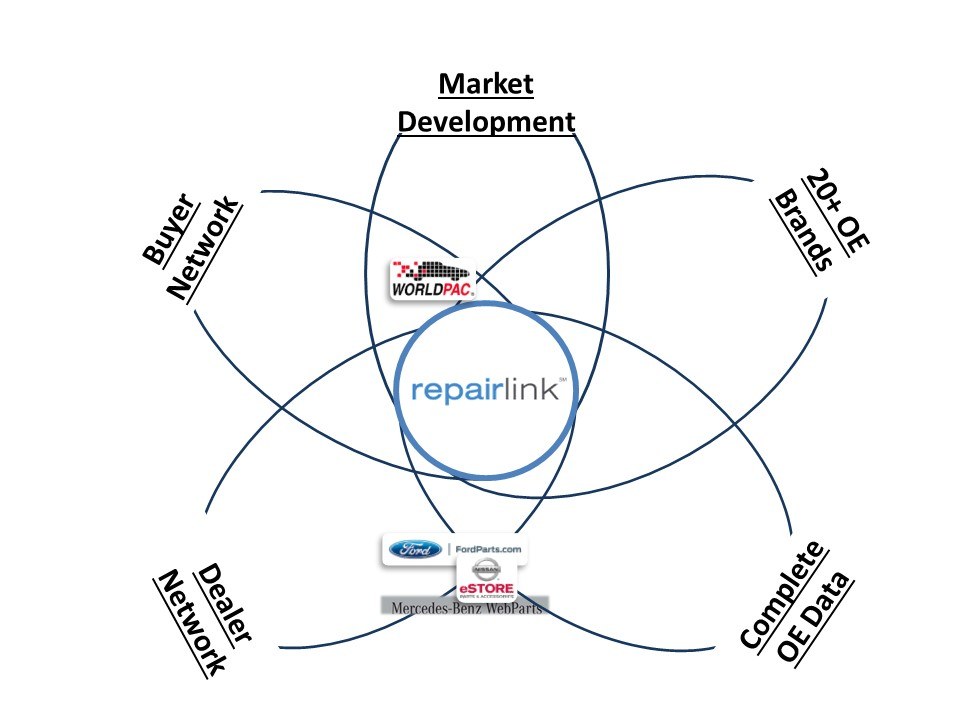There are numerous parts procurement systems available to help you sell more mechanical parts. Depending on your objectives, it may not always appear black and white in identifying which is best for your parts department.
When we say a parts procurement system, we mean a computer application or service. A lot of these systems, like RepairLink, are web-based, providing the ability to log in from anywhere to access your parts department’s mechanical parts sales data. Being web-based also means your information will never “crash” like it could on a local computer.
How parts procurement systems compare
Here’s a simple breakdown of common parts procurement systems based on brand coverage, market development, buyer networks (shops), dealer networks and complete OE data availability.

Why are these elements important when it comes to selling parts?
- Brand coverage – think about this from a shop’s or customer’s perspective. Most repair facilities (unless they are specialty shops) repair any brand that comes into their shop. While parts are never identical brand-to-brand, shops don’t have the time to go to fifteen different websites to buy parts. If they had it their way, they would buy all their parts from one source. With an online parts marketplace like RepairLink, your shop customers can shop and purchase OE parts from over 20 OE brands without leaving their browser.Going to different sources takes time – something repairers take very seriously. In fact, did you know a technician’s time is worth $3 – $6 per minute?¹ They simply don’t have time (or money) to waste.
- Complete OE data – Not only do shops need diagrams and illustrations, but also the latest and most up-to-date data available. Whatever parts procurement solution you choose, make sure to ask where their data comes from and how often it is updated. Outdated data often leads to the wrong part being ordered, which means more time lost due to returning the part and reordering the right part.
- Dealer Network – When you’re looking for a parts procurement system, make sure that solution has a solid network of dealers who use the solution, too. Why? This goes back to brand coverage and how most repair facilities will repair any vehicle that comes into their shop. Shops generally do not control what brands they repair. Sometimes the parts they use aren’t the brands you sell, and that’s OK! An expansive dealer network means their parts procurement solution is the answer to any parts they need. While they may not order from you this time, they likely will next time. So the dealer down the street from you is not your competition, but your ally. You help each other compete against the real competition – the aftermarket.
For example, shops can find parts from over 20 brands and 4,500 dealers on RepairLink. Not all these dealers will be in a shop’s specific market, but there is likely enough brand coverage for shops to continuously go to one source they know will always have their part.
- Buyer network – Like the shop-side, as a dealer, you want to make sure there are enough shops using the parts procurement system you invest in. Now, “using” the parts procurement system is relative. For example, with RepairLink, many shops use RepairLink Shop for its diagrams and illustrations to identify the parts they need, and then call the dealer to purchase their parts. While it’s always better for shops to buy online for better order accuracy, sometimes shops feel more comfortable calling. Many dealers like to provide their inventory online via RepairLink for just that reason. Having a presence in an online parts marketplace like RepairLink ensures they stay in front of shops – regardless if shops order from them through RepairLink or pick up the phone.RepairLink has over 30,000 shops looking up and shopping for parts monthly; about half purchase directly online (and are spending over $15 million a month in the process).
- Market development – Many parts procurement systems have limitations. Whether it’s per brand or location-specific, you want an established solution that’s trusted by shops across the country. Choosing a solution with boundaries, like locations, doesn’t give you a lot of room for your customer base to grow – there is always a limit.You can find RepairLink in every U.S. market with a franchised dealer. Any franchised dealer (all 18,000 nationwide) can add RepairLink as their parts procurement system.
¹180 Business Solutions, 2017.


